This page is to assist landowners who are planning to subdivide. It applies to all types of projects, from small two-lot subdivisions to large commercial and industrial developments.
When subdividing land, it is the developer’s responsibility to provide adequate electrical infrastructure to:
- supply electricity to every lot
- provide public lighting
This is generally a condition outlined within your development consent. It applies to all forms of subdivisions, including:
- Residential, rural, or commercial subdivisions, including small two-lot subdivisions
- Multi-tenancy developments, such as apartments or shopping complexes
- Industrial precincts and commercial parks
- Closed gate or private subdivisions
- Village-type residential developments, such as retirement villages.
Your local council may require the developer of a subdivision, boundary adjustment or lot consolidation to obtain a Notice of Arrangement (NOA) from Essential Energy to prove you meet these requirements before issuing a development consent.
How to apply
You are required to submit a “Subdivision Residential and Commercial” application via our Essential Connections Portal. We will then assess your application and determine the next steps for your development.
The next steps will depend on whether the local electricity grid needs to be upgraded before it can meet your developments electricity needs.
There are three possible outcomes of a connection application:
|
Outcome 1 - NoA Preliminary Assessment What it means- We will notify you that you can apply for a NoA once certain conditions are met. Next Steps- Meet the conditions outlined by us and let us know they have been completed. We can then process your NoA. |
| Outcome 2 - NoA Available What it means- we will begin the process of issuing you a NoA. If we require any further information, we will advise you during the process. We will notify you when your NoA is ready. You will be required to pay the NoA fee before being issued your NoA. |
|
Outcome 3 - Standard Connection (Subdivision) Offer What it means -Your local network requires augmentation works to supply your development. We will issue you with a Standard Connection (Subdivision) Offer letter. Next steps -You will need to engage a Level 3 ASP and Level 1 ASP to progress to the next stages of your project. Read on below for the process for completing connection works. |
For further information on how to apply for a NoA, including user guides and videos, please see our NoA knowledge article.
Connection applications are very technical. We strongly recommend you engage an Accredited Service Provider (ASP) to help you.
An ASP can:
- give advice on the most likely pathway prior to application
- ensure technical information is accurate
- submit the appropriate application on your behalf
- help facilitate any required augmentation work.
Completing connection works
Connection works in New South Wales are contestable. That means customers can choose who provides their connections services.
Businesses authorised to work on our network are called Accredited Service Providers (ASPs). Read more about different types of ASPs and electrical contractors
If you received a standard connection offer, you need two types of ASPs:
- a Level 3 ASP to design the extension or upgrade
- a Level 1 ASP to build the approved design.
Your ASPs will work with us to ensure their work meets our design, safety and operational standards.
You can find a list of ASPs and the type of work they can perform at energysaver.nsw.gov.au.
You are eligible for an NOA once all connection work is complete.
Responsibility for costs
As the developer, you are responsible for all costs for connecting your development to our network.
Costs can include:
- upstream augmentation of the existing distribution system
- connection works to connect the development to the network
- the electrical infrastructure inside the development and
- any Essential Energy fees and charges.
Our Connection Policy details these connection requirements. View the Connection Policy




